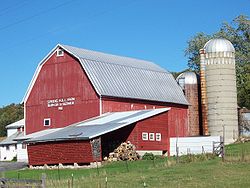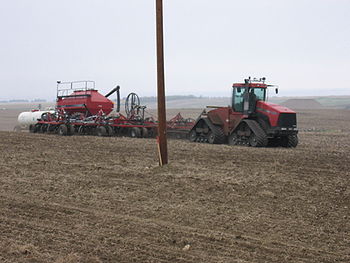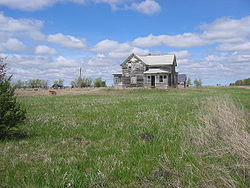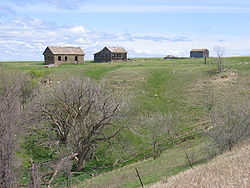
Family farm
Encyclopedia

Farm
A farm is an area of land, or, for aquaculture, lake, river or sea, including various structures, devoted primarily to the practice of producing and managing food , fibres and, increasingly, fuel. It is the basic production facility in food production. Farms may be owned and operated by a single...
owned and operated by a family, and often passed down from generation
Generation
Generation , also known as procreation in biological sciences, is the act of producing offspring....
to generation. It is the basic unit of the mostly agricultural economy
Economic system
An economic system is the combination of the various agencies, entities that provide the economic structure that defines the social community. These agencies are joined by lines of trade and exchange along which goods, money etc. are continuously flowing. An example of such a system for a closed...
of much of human history and continues to be so in developing nations
Developing country
A developing country, also known as a less-developed country, is a nation with a low level of material well-being. Since no single definition of the term developing country is recognized internationally, the levels of development may vary widely within so-called developing countries...
. Alternatives to family farms include those run by agribusiness
Agribusiness
In agriculture, agribusiness is a generic term for the various businesses involved in food production, including farming and contract farming, seed supply, agrichemicals, farm machinery, wholesale and distribution, processing, marketing, and retail sales....
, colloquially known as factory farms
Factory farming
Factory farming is a term referring to the process of raising livestock in confinement at high stocking density, where a farm operates as a factory — a practice typical in industrial farming by agribusinesses. The main products of this industry are meat, milk and eggs for human consumption...
, or by collective farming
Collective farming
Collective farming and communal farming are types of agricultural production in which the holdings of several farmers are run as a joint enterprise...
.
United States legal definition
As defined by USDA regulations to farm loan programs (e.g. those administered by the Farm Service AgencyFarm Service Agency
The Farm Service Agency is the USDA agency into which were merged several predecessor agencies, including the Agricultural Stabilization and Conservation Service . The ASCS was, as the FSA is now, primarily tasked with the implementation of farm conservation and regulation laws around the country...
), a family farm is a farm that
- produces agricultural commodities for sale in such quantities so as to be recognized in the community as a farm and not a rural residence;
- produces enough income (including off-farm employment) to pay family and farm operating expenses, pay debts, and maintain the property;
- is managed by the operator;
- has a substantial amount of labor provided by the operator and the operator’s family; and
- may use seasonal labor during peak periods and a reasonable amount of full-time hired labor.
(For exact language, see 7 U.S.C. 1941.4,1943.4).
Perceptions of the family farm
In developed countriesDeveloped country
A developed country is a country that has a high level of development according to some criteria. Which criteria, and which countries are classified as being developed, is a contentious issue...
the family farm is viewed sentimentally, as a lifestyle to be preserved for tradition's sake, or as a birthright
Birthright
Birthright is a term that refers to something that is acquired or inherited at birth. It may further refer to:- Ancient and modern Law :* primogeniture, rights of the firstborn* birthright citizenship- Literature :...
. It is in these nations very often a political rallying cry against change in agricultural policy
Agricultural policy
Agricultural policy describes a set of laws relating to domestic agriculture and imports of foreign agricultural products. Governments usually implement agricultural policies with the goal of achieving a specific outcome in the domestic agricultural product markets...
, most commonly in France
France
The French Republic , The French Republic , The French Republic , (commonly known as France , is a unitary semi-presidential republic in Western Europe with several overseas territories and islands located on other continents and in the Indian, Pacific, and Atlantic oceans. Metropolitan France...
, Japan
Japan
Japan is an island nation in East Asia. Located in the Pacific Ocean, it lies to the east of the Sea of Japan, China, North Korea, South Korea and Russia, stretching from the Sea of Okhotsk in the north to the East China Sea and Taiwan in the south...
, and the United States
United States
The United States of America is a federal constitutional republic comprising fifty states and a federal district...
, where rural lifestyles are often regarded as desirable. In these countries, strange bedfellows can often be found arguing for similar measures despite otherwise vast differences in political ideology. For example, Patrick Buchanan and Ralph Nader
Ralph Nader
Ralph Nader is an American political activist, as well as an author, lecturer, and attorney. Areas of particular concern to Nader include consumer protection, humanitarianism, environmentalism, and democratic government....
, both candidates for the office of President of the United States
President of the United States
The President of the United States of America is the head of state and head of government of the United States. The president leads the executive branch of the federal government and is the commander-in-chief of the United States Armed Forces....
, held rural rallies
Demonstration (people)
A demonstration or street protest is action by a mass group or collection of groups of people in favor of a political or other cause; it normally consists of walking in a mass march formation and either beginning with or meeting at a designated endpoint, or rally, to hear speakers.Actions such as...
together and spoke for measures to preserve the so-called family farm. On other economic matters they were seen as generally opposed, but found common ground on this one.
The social roles of family farms are much changed today. Until recently, staying in line with traditional and conservative sociology, the heads of the household were usually the oldest man followed closely by his oldest sons. The wife generally took care of the housework, child rearing, and financial matters pertaining to the farm. However, agricultural activities have taken on many forms and change over time. Agronomy
Agronomy
Agronomy is the science and technology of producing and using plants for food, fuel, feed, fiber, and reclamation. Agronomy encompasses work in the areas of plant genetics, plant physiology, meteorology, and soil science. Agronomy is the application of a combination of sciences like biology,...
, horticulture
Horticulture
Horticulture is the industry and science of plant cultivation including the process of preparing soil for the planting of seeds, tubers, or cuttings. Horticulturists work and conduct research in the disciplines of plant propagation and cultivation, crop production, plant breeding and genetic...
, aquaculture
Aquaculture
Aquaculture, also known as aquafarming, is the farming of aquatic organisms such as fish, crustaceans, molluscs and aquatic plants. Aquaculture involves cultivating freshwater and saltwater populations under controlled conditions, and can be contrasted with commercial fishing, which is the...
, silviculture
Silviculture
Silviculture is the practice of controlling the establishment, growth, composition, health, and quality of forests to meet diverse needs and values. The name comes from the Latin silvi- + culture...
, and apiculture, along with traditional plants and animals, all make up aspects of today's family farm. Farm wives often need to find work away from the farm to supplement farm income and children sometimes have no interest in farming as their chosen field of work.
Bolder promoters argue that as agriculture has become more efficient with the application of modern management
Management
Management in all business and organizational activities is the act of getting people together to accomplish desired goals and objectives using available resources efficiently and effectively...
and new technologies in each generation, the idealized classic family farm is now simply obsolete, or more often, unable to compete without the economies of scale
Economies of scale
Economies of scale, in microeconomics, refers to the cost advantages that an enterprise obtains due to expansion. There are factors that cause a producer’s average cost per unit to fall as the scale of output is increased. "Economies of scale" is a long run concept and refers to reductions in unit...
available to larger and more modern farms. Advocates argue that family farms in all nations need to be protected, as the basis of rural society and social stability.
Viability of the family farm

Depending on the type and size of independently owned operation, some limiting factors are:
- Economies of scale: Larger farms are able to bargain more competitively, purchase more competitively, profit from economic highs, and weather lows more readily through monetary inertia than smaller farms.
- Cost of inputs: fertilizer and other agrichemicals can fluctuate dramatically from season to season, partially based on oil prices, a range of 25% to 200% is common over a few year period.
- oil prices: Directly (for farm machinery) and somewhat less directly (long distance transport; production cost of agrichemicals), the cost of oil significantly impacts the year-to-year viability of all mechanized conventional farms.
- commodity futures: the predicted price of commodityCommodityIn economics, a commodity is the generic term for any marketable item produced to satisfy wants or needs. Economic commodities comprise goods and services....
crops, hogs, grain, etc., can determine ahead of a season what seems economically viable to grow. - technology user agreements: a less publicly known factor, patented GE seed that is widely used for many crops, like cotton and soy, comes with restrictions on use, which can even include who the crop can be sold to.
- wholesale infrastructure: A farmer growing larger quantities of a crop than can be sold directly to consumers has to meet a range of criteria for sale into the wholesale market, which include harvest timing and graded quality, and may also include variety, therefore, the market channel really determines most aspects of the farm decisionmaking.
- availability of financing: Larger farms today often rely on lines of credit, typically from banks, to purchase the agrichemicals, and other supplies needed for each growing year. These lines are heavily affected by almost all of the other constraining factors.
- government economic intervention: In some countries, notably the US and EU, government subsidies to farmers, intended to mitigate the impact on domestic farmers of economic and political activities in other areas of the economy, can be a significant source of farm income. Bailouts, when crises such as drought or the "mad cow disease" problems hit agricultural sectors, are also relied on. To some large degree, this situation is a result of the large-scale global markets farms have no alternative but to participate in.
- government and industry regulation: A wide range of quotas, marketing boards and legislation governing agriculture impose complicated limits, and often require significant resources to navigate. For example, on the small farming end, in many jurisdictions, there are severe limits or prohibitions on the sale of livestock, dairy and eggs. These have arisen from pressures from all sides: food safety, environmental, industry marketing.
- real estate prices: The growth of urban centers around the world, and the resulting urban sprawlUrban sprawlUrban sprawl, also known as suburban sprawl, is a multifaceted concept, which includes the spreading outwards of a city and its suburbs to its outskirts to low-density and auto-dependent development on rural land, high segregation of uses Urban sprawl, also known as suburban sprawl, is a...
have caused the price of centrally located farmland to skyrocket, while reducing the local infrastructure necessary to support farming, putting effectively intense pressure on many farmers to sell out.
Over the last century, the people of developed nations have collectively taken most of the steps down the path to this situation. Individual farmers opted for successive waves of new technology, happily "trading in their horses for a tractor", increasing their debt and their production capacity. This in turn required larger, more distant markets, and heavier and more complex financing. The public willingly purchased increasingly commoditized, processed, shipped and relatively inexpensive food. The availability of an increasingly diverse supply of fresh, uncured, unpreserved produce and meat in all seasons of the year (oranges in January, freshly killed steers in July, fresh pork rather than salted, smoked, or potassium-impregnated ham) opened an entirely new cuisine and an unprecedented healthy diet to millions of consumers who had never enjoyed such produce before. These abilities also brought to market an unprecedented variety of processed foods, such as corn syrup and bleached flour. For the family farm this new technology and increasingly complex marketing strategy has presented new and unprecedented challenges, and not all family farmers have been able to effectively cope with the changing market conditions.
Family farms in the 21st century

North America
North America is a continent wholly within the Northern Hemisphere and almost wholly within the Western Hemisphere. It is also considered a northern subcontinent of the Americas...
produced much less food per acre than it does nowadays. A likely conclusion is that for a time in the middle decades of the last century, a large number of farms achieved a temporarily comfortable position by capitalizing on rapidly emerging new technologies, markets, and growth-oriented philosophies. As growth and "production efficiency" kept increasing, this position began to reverse noticeably, at least by the 1970s. The number of farms, and of farm families living on the land, has dropped every decade in the United States since 1920. In part this was a function of economies of scale and competitive pressures. In part it may be perceived as an indication that "family farming", in its raw, realistic form, is just plain hard work, with limited social and cultural opportunities, and competes poorly as an occupation and a "lifestyle" with urban and suburban opportunities.
In the current situation, for the independent "family farmer" to regain any sort of practical economic independence, it would seem necessary that the entire food industry
Food industry
The food production is a complex, global collective of diverse businesses that together supply much of the food energy consumed by the world population...
be restructured. Furthermore, given the extreme number of defunct family farms, it is not so much a matter of saving or preserving the family farm (whatever it was, it is effectively already gone), but of using the remaining knowledge, expertise and farms as the framework for the "new family farm." A serious question, however, is whether the entire food system should be "restructured" in order to preserve a failed or perhaps mythological ideal, or whether the population of the world, now approaching 7 billion people, will be sustained by a return to labor-intensive farming and local mom and pop marketing practices. The answer, however, can hardly be considered immediately obvious, especially since many of these 7 billion people might find they prefer growing food to current urban lower-class options such as data entry, food service, and telemarketing.

North Dakota
North Dakota is a state located in the Midwestern region of the United States of America, along the Canadian border. The state is bordered by Canada to the north, Minnesota to the east, South Dakota to the south and Montana to the west. North Dakota is the 19th-largest state by area in the U.S....
is illuminating. Although originally developed as enormous "bonanza farms" in the 1870s, these were broken up and sold off into smaller holdings and other parts of the state were homesteaded in quarter section (160 acre (0.6474976 km²)) farms. The state was predominantly farmed by individuals and families by the 1920s and 1930s. The state enjoyed a populist boom in the early 20th century, as farmer-controlled legislatures seized control of the marketing and sale of agricultrual products and placed it in state-sponsored "cooperatives" to enable smaller producers to escape the grip of the railroads and the industrialized food merchants. These retrograde polices have long since been abandoned as unrealistic and unsustainable. In 2007, most farmland in North Dakota remains owned by individuals. Corporate ownership of farmland has been illegal since a statewide voter initiative in 1933. The scale of agriculture in North Dakota, however, is a far cry from the idyllic conception of an intimate hands-on family operation of mixed agriculture. The typical dry-land wheat farm in North Dakota consists of several thousand acres with equipment on a scale to match. The produce of these farms is assembled on 120-car trains and shipped to distant markets as part of the international stream of commerce.

The thousands of abandoned or obliterated farmsteads and other evidence of rural depopulation in North Dakota, including many now-vacant and deteriorated homesteads which were thriving family farms into the 1970s, are a counterpoint to romantic notions of "family farming" in the 21st century.
Local food and the organic movement
In the last few decades there has been a resurgence of interest in organicOrganic food
Organic foods are foods that are produced using methods that do not involve modern synthetic inputs such as synthetic pesticides and chemical fertilizers, do not contain genetically modified organisms, and are not processed using irradiation, industrial solvents, or chemical food additives.For the...
and free range
Free range
thumb|250px|Free-range chickens being fed outdoors.Free range is a term which outside of the United States denotes a method of farming husbandry where the animals are allowed to roam freely instead of being contained in any manner. In the United States, USDA regulations apply only to poultry and...
foods. A percentage of consumers have begun to question the viability of industrial agriculture
Industrial agriculture
Industrial farming is a form of modern farming that refers to the industrialized production of livestock, poultry, fish, and crops. The methods of industrial agriculture are technoscientific, economic, and political...
practices and have turned to organic groceries that sell products produced on family farms including not only meat and produce but also such things as wheat germ bread
Bread
Bread is a staple food prepared by cooking a dough of flour and water and often additional ingredients. Doughs are usually baked, but in some cuisines breads are steamed , fried , or baked on an unoiled frying pan . It may be leavened or unleavened...
s and natural lye soap
Soap
In chemistry, soap is a salt of a fatty acid.IUPAC. "" Compendium of Chemical Terminology, 2nd ed. . Compiled by A. D. McNaught and A. Wilkinson. Blackwell Scientific Publications, Oxford . XML on-line corrected version: created by M. Nic, J. Jirat, B. Kosata; updates compiled by A. Jenkins. ISBN...
s (as opposed to bleached white breads and petroleum based detergent bars). Others buy these products direct from family farms. The "new family farm" provides an alternative market in some localities with an array of traditionally and naturally produced products.
Such "organic" and "free-range" farming is attainable where a significant number of affluent urban and suburban consumers willingly pay a premium for the ideals of "locally produced produce" and "humane treatment of animals". Sometimes, these farms are hobby or part-time ventures, or supported by wealth from other sources. Viable farms on a scale sufficient to support modern families at an income level commensurate with urban and suburban upper middle class families are often large scale operations, both in area and capital requirements. These farms, family owned and operated in a technologically and economically conventional manner, produce crops and animal products oriented to national and international markets, rather than to local markets.
In assessing this complex economic situation, it is important to consider all sources of income available to these farms; for instance, the millions of dollars in farm subsidies which the United States government offers each year. As fuel prices rise, foods shipped to national and international markets are already rising in price.
See also
- Agricultural policyAgricultural policyAgricultural policy describes a set of laws relating to domestic agriculture and imports of foreign agricultural products. Governments usually implement agricultural policies with the goal of achieving a specific outcome in the domestic agricultural product markets...
- Agroecological restorationAgroecological restorationAgroecological restoration is the practice of re-integrating natural systems into agriculture in order to maximize sustainability, ecosystem services, and biodiversity...
- Back-to-the-land movement
- Family farm hog pen
- Farm AidFarm AidFarm Aid started as a benefit concert on September 22, 1985, in Champaign, Illinois, held to raise money for family farmers in the United States...
- Gentleman's farmGentleman's farmA gentleman's farm is an extremely small or non-operative farm. They are generally small acreages that are not used to produce large amounts of food, grain, or livestock for major markets. Gentleman's farms are also used as hobby farms, for horse rearing, or as bed and breakfast establishments...
- Hobby farmHobby farmA hobby farm is a smallholding or small farm that is maintained without expectation of being a primary source of income. Some are merely to provide some recreational land, and perhaps a few horses for the family's children...
- Local foodLocal foodLocal food or the local food movement is a "collaborative effort to build more locally based, self-reliant food economies - one in which sustainable food production, processing, distribution, and consumption is integrated to enhance the economic, environmental and social health of a particular...
External links
- CBC Digital Archives - What's Happening to the Family Farm?
- Found Family Farm Family farm with educational farm tours
- Dairy Farming Today Family Farm Profiles and an educational virtual farm tour
- Agriculture Resource for the secondary school teacher
Further reading
- Farmers cannot afford to give up their day jobManning, IowaManning is a city in Carroll County, Iowa, United States, along Iowa Highway 141. The population was 1,490 at the 2000 census. It is named for Orlando Harrison Manning, a Lieutenant Governor of Iowa.-History:...
-- Anthan, GeorgeGeorge AnthanGeorge Anthan is the former Washington Bureau Chief for the Des Moines Register. He is the winner of several awards for outstanding journalism, including the Pulitzer Prize, the Raymond Clapper and National Press Club awards. Anthan also won an Alicia Patterson Journalism Fellowship in 2004 to...
and Lee, Jennifer Dukes - How Industrialization is Restructuring Food Production -- Hamilton, NeilNeil Hamilton (lawyer)Neil D. Hamilton is an American lawyer and agricultural economics writer. Hamilton currently holds the Dwight D. Opperman Chair of Law at Drake Law School , where he is also the Director of the Agricultural Law Center. He is also chairman of the Agriculture Law Section of the Association of...
- Nature's Metropolis: Chicago and the Great West -- Cronan, WilliamWilliam CrononWilliam 'Bill' Cronon is the Frederick Jackson Turner and Vilas Research Professor of History, Geography, and Environmental Studies at the University of Wisconsin–Madison...
- Iowa: Living in the Third World -- Wolf, RobertRobert WolfRobert Wolf is an American writer, journalist, and entrepreneur.Wolf is a past recipient of the Bronze Medal for radio editorial/commentary and the Sigma Delta Chi Award , both from the Society of Professional Journalists...
- Rural America in a New Century -- Drabenstott, MarkMark DrabenstottMark Drabenstott is a vice-president of the Federal Reserve Bank of Kansas City and the director of the Center for the Study of Rural America...
- The Value of Rural America -- Rowley, Thomas D.
- Why Americans Value Rural Life -- Danbom, David B.David B. DanbomDavid B. Danbom is a historian, author, columnist, and retired professor of agricultural history at North Dakota State University. Danbom spent nine years on the Fargo Historic Preservation Commission...
- Sunset Unlimited: The Southern Pacific Railroad and the Development of the American West -- Orsi, Richard J.

